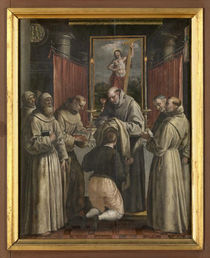The Catholic Defender: Saint Bridget of Sweden patron saint of Europe
- Donald Hartley

- Jul 22
- 3 min read
Updated: Jul 23
Deepertruth with special permission and aid with Franiciscan Media, a great team for the Lord

The nuns wear crowns made of three metal bands with five red stones representing the five wounds that Jesus suffered on the Cross. Bridget herself, however, almost always wears a white veil on her head rather than the Brigittine crown.
1303, Sweden—died July 23, 1373, Rome [Italy]; canonized October 8, 1391; feast day July 23, formerly October 8), patron saint of Sweden, founder of the Bridgittines (Order of the Most Holy Savior), and a mystic whose revelations were influential during the Middle Ages.
From age 7 on, Bridget had visions of Christ crucified. Her visions formed the basis for her activity—always with the emphasis on charity rather than spiritual favors.
she was born of a noble father and a slave mother and was sold along with her mother to a Druid, whom she later converted to Christianity. On being set free, she returned to her father, who tried to marry her to the king of Ulster.
She lived her married life in the court of the Swedish king Magnus II. Mother of eight children—the second eldest was Saint Catherine of Sweden—Bridget lived the strict life of a penitent after her husband’s death.
Saint Bridget of Ireland was a determined, faithful Catholic who was responsible for starting convents and monasteries throughout Ireland. Bridget's Celtic name, Brigid, which means “fiery arrow,” can be traced back to the goddess of the same name with whom Bridget is often conflated.
Bridget constantly strove to exert her good influence over Magnus; while never fully reforming, he did give her land and buildings to found a monastery for men and women. This group eventually expanded into an Order known as the Bridgetines.

In 1350, a year of jubilee, Bridget braved a plague-stricken Europe to make a pilgrimage to Rome. Although she never returned to Sweden, her years in Rome were far from happy, being hounded by debts and by opposition to her work against Church abuses.
The legend of Brigid's cloak is often told. It's the story about the manner in which she came to acquire the land to build her monastery at Kildare. It is often regarded as one of the first miracles associated with her.
Brigid would go on to become a nun, and a disciple of St. Patrick. She founded several monasteries, including a vital center of religion and learning in Kildare, as well as a school of art that taught metalwork and illumination.
A final pilgrimage to the Holy Land, marred by shipwreck and the death of her son, Charles, eventually led to her death in 1373. In 1999, Bridget, Saint Catherine of Siena and Saint Teresa Benedicta of the Cross, were named co-patronesses of Europe.
Bridget’s visions, rather than isolating her from the affairs of the world, involved her in many contemporary issues, whether they be royal policy or the years that the legitimate Bishop of Rome lived in Avignon, France. She saw no contradiction between mystical experience and secular activity, and her life is a testimony to the possibility of a holy life in the marketplace.
Brigid's Cross (Cros Bríde in Irish) is a cross woven from rushes, with 4 arms tied at the end and meeting in a woven patterned square in the centre. Traditionally they were displayed over the door of a house to ward off evil. The tradition marks the beginning of spring, St Brigid's Day being the 1st February.
O God, you give us joy, through the power of the intercession of Blessed Brigid. Graciously grant that we may be assisted by her merits and her example. We ask this through Christ our Lord. Amen.





















Comments